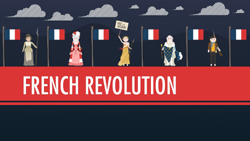| Mass communications as a propaganda tool was born
during World War I as governments worked to win citizen support for the
war. In the 1920s and 1930s, people worldwide felt the effects of the Great
Depression and political instability. The arts and sciences reflected the
changes occurring in people’s ideas about the world.
Mass Culture and Leisure
-
Hitler used radio and movies as propaganda tools to promote
Nazism.
A series of inventions in the late 1800s had led the way
for a revolution in mass communications. Especially important was Marconi’s
discovery of wireless radio waves. A musical concert transmitted in June
1920 had a major impact on radio broadcasting. Broadcasting facilities
were built in the United States, Europe, and Japan during 1921 and 1922.
At the same time, the mass production of radios began. In 1926 there were
2.2 million radios in Great Britain. By the end of the 1930s, there were
9 million.
Although motion pictures had first emerged in the 1890s,
full-length features did not appear until shortly before World War I.
The Italian film Quo Vadis and the American film
Birth
of a Nation made it apparent that cinema was an important new form
of mass entertainment.
By 1939, about 40 percent of adults in the more developed
countries were attending a movie once a week. That figure had increased
to 60 percent by the end of World War II.
Use of Radio and Movies for Propaganda
Of course, radio and the movies could be used for political
purposes. Radio offered great opportunities for reaching the masses. This
became obvious when it was discovered that Adolf Hitler’s fiery speeches
made just as great an impact on people when heard over the radio as they
did in person. The Nazi regime encouraged radio listening by urging manufacturers
to produce inexpensive radios that could be bought on an installment plan.
Film, too, had propaganda potential, a fact not lost on
Joseph
Goebbels (GUHR•buhlz), the propaganda minister of Nazi Germany.
Believing that film was one of the “most modern and scientific
means of influencing the masses,” Goebbels created a special film division
in his Propaganda Ministry. The film division supported the making of both
documentaries—nonfiction films—and popular feature films that carried the
Nazi message.
Nazi Propaganda Film
In 1934 Adolf Hitler commissioned Leni Riefenstahl
to film the 1934 Nazi party rally in Nuremberg. The resulting film, Triumph
of the Will, is considered one of the greatest documentary films of
all time—and a chilling piece of Nazi propaganda.
Riefenstahl later said of the film, “It reflects the truth
that was then, in 1934, history. It is therefore a documentary, not a propaganda
film.” It is true that the film is the record of an actual event that happened
at a specific time. In that respect, it is a documentary. However, Riefenstahl’s
powerful and positive images of Hitler as a kind of savior make it propaganda.
For example, at the beginning of the film, Hitler’s plane descends from
the sky almost like the chariot of a god coming to visit Earth. The film
was edited and set to the music of Richard Wagner, building to a climax
when Hitler takes the stand. In this way, it attempts to influence
the audience’s attitude toward the Nazis—which is the goal of propaganda.
Today many of Riefenstahl’s films are considered masterpieces,
in spite of the fact that they glorify the Nazis.
The Uses of Leisure
After World War I, the assembly line and mass production
took hold in industry. More consumer goods were available, and more people
could buy them because they had more income or credit. By 1920, the eighthour
day had been established for many workers. Gradually, it became the norm.
This new work pattern meant more free time for the leisure
activities that had emerged by 1900. Professional sporting events were
an important part of mass leisure. Travel was another favorite activity.
Trains, buses, and cars made trips to beaches or holiday
resorts popular and affordable. Mass leisure offered new ways for totalitarian
states to control the people. The Nazi regime, for example, adopted a program
called Kraft durch Freude (“Strength through Joy”).
The program offered a variety of leisure activities to fill the free time
of the working class. These activities included concerts, operas, films,
guided tours, and sporting events.
How did the “Strength through
Joy” program help support the Nazi regime?
REVIEW & DO
NOW
Answer the following questions in your spiral notebooks: |
| . |
. |
|
|
Arts and Science
-
The art, literature, and scientific breakthroughs produced
after World War I both embraced the past and reflected uncertainty for
the future.
Four years of devastating war had left many Europeans with
a profound sense of despair. The Great Depression and the growth of violent
fascist movements only added to the despair created by the war.
Many people began looking at themselves differently; their
future seemed uncertain. With political, economic, and social uncertainties
came intellectual uncertainties. These were evident in the artistic, intellectual,
and scientific achievements of the years following World War I.
Art: Nightmares and New Visions
After 1918, artistic trends mainly reflected developments
made before the war. Abstract art, for example, became ever more popular.
In addition, a prewar fascination with the absurd and the unconscious content
of the mind seemed even more appropriate in light of the nightmare landscapes
of the World War I battlefronts. “The world does not make sense, so why
should art?” was a common remark. This sentiment gave rise to both the
Dada
movement and surrealism.
The dadaists were artists who were obsessed
with the idea that life has no purpose. They were revolted by what they
saw as the insanity of life and tried to express that feeling in their
art. Dada artist Hannah Höch, for example, used photomontage
(a picture made of a combination of photographs) to comment on women’s
roles in the new mass culture.
A more important artistic movement than dadaism was surrealism.
By portraying the unconscious—fantasies, dreams, and even nightmares—the
surrealists sought to show the greater reality that exists beyond the world
of physical appearances. One of the world’s foremost surrealist painters,
the Spaniard Salvador Dalí, placed recognizable objects
in unrecognizable relationships. Dalí created a strange world in
which the irrational became visible.
Not everybody accepted modern art forms. Many people denounced
what they saw as decay in the arts. In Germany, Hitler and the Nazis believed
that they were creating a new and genuine German art to glorify heroic
Germans. What the Nazis developed, however, was actually derived from nineteenth-century
folk art and emphasized realistic scenes of everyday life.
Literature: The Search for the
Unconscious
The interest in the unconscious also appeared in new
literary techniques. “Stream of consciousness” was a technique used by
writers to show the innermost thoughts of each character.
The most famous example is the novel Ulysses, published
by the Irish writer James Joyce in 1922. Ulysses
tells the story of one day in the life of ordinary people in Dublin.
The novels of German writer Hermann Hesse
reflect the influence of both Freud’s psychology and Asian religions. His
works often focus on the spiritual loneliness of modern human beings in
a mechanized urban society. In Siddhartha and Steppenwolf,
Hesse uses Buddhist ideas to show the psychological confusion of modern
existence. Hesse’s novels had a great impact on German youth in the 1920s.
He won the Nobel Prize for literature in 1946.
The Heroic Age of Physics
The prewar physics revolution begun by Albert Einstein
continued in the 1920s and 1930s. In fact, Ernest Rutherford, one of the
physicists who showed that the atom could be split, called the 1920s the
“heroic age of physics.”
The unfolding new physics undermined the classical physics
of Newton. Newtonian physics had made people believe that all phenomena
could be completely defined and predicted. In 1927 German physicist Werner
Heisenberg’s uncertainty principle shook this belief. Physicists
knew that atoms were made up of smaller parts (subatomic particles). The
unpredictable behavior of these subatomic particles is the basis for the
uncertainty principle.
Heisenberg’s theory essentially suggests that all physical
laws are based on uncertainty. The theory’s emphasis on randomness challenged
Newtonian physics and, in a way, represented a new worldview. Thus, the
principle of uncertainty fit in well with the other uncertainties of the
interwar years.
How did Heisenberg’s uncertainty
principle challenge the Newtonian worldview?
REVIEW & DO
NOW
Answer the following questions in your spiral notebooks: |
| . |
. |
|
|
|





